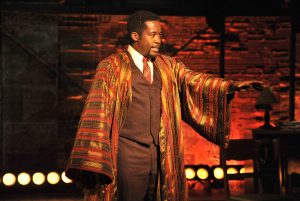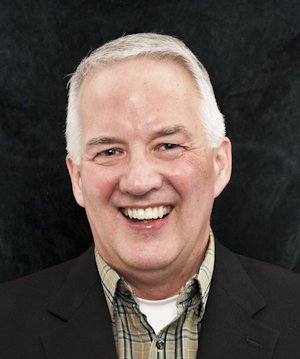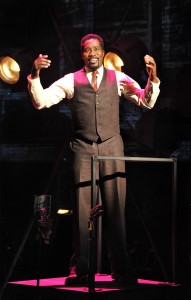World Premiere of Paul Robeson Play at La Jolla Playhouse Resonates with Contemporary Events
Moisés Kaufman’s Tectonic Theatre Project made its reputation by producing what might be called “documentary theatre:” projects that are based on research into real-life events. Among Tectonic’s more well-known theatre pieces have been Gross Indecency: The Three Trials of Oscar Wilde, The Laramie Project, and The Laramie Project: Ten Years Later.
Now Tectonic is taking a “produced in association with” credit for another documentary play, The Tallest Tree in the Forest. Written by and starring Daniel Beaty and directed by Mr. Kaufman, this La Jolla Playhouse co-world premiere (also produced by the Kansas City Repertory Theatre) runs through November 3.
Mr. Beaty’s subject is Paul Robeson, the singer and actor who rose to the heights of his profession prior to and during World War II and then plummeted to the depths by his open admiration for equal treatment of people of color within the Soviet Union, an admiration that soured once Stalin came to power. Nevertheless, Mr. Robeson was called before the House UnAmerican Activities Committee, and like so many artists so called, he lost his prestige and his ability to work as an entertainer for years to come.
Mr. Beaty both narrates the performance as Robeson and sings in the style of Robeson (there are fourteen songs included, many of them spirituals, which Mr. Robeson often performed in the many concerts he gave around the world). But, Mr. Beaty has written a play, not a one-man show, per se, and he also portrays the other characters in the play, generally by adopting a dialect (designed and masterfully coached by Paul Meier) and a posture as the character. The secondary characters that Mr. Beaty plays inevitably exhibit a certain amount of dimension and depth. Surprisingly, the same is not true of Mr. Beaty’s portrayal of Robeson himself, which tends toward being flat and one-dimensional.
Mr. Kaufman’s method of directing Tectonic projects tends to pace the dialogue speedily, with words tumbling out of performers’ mouths. Not so here: Mr. Kaufman does not push Mr. Beaty to move more quickly than is comfortable, particularly in shifting from one character to another. A sense of movement and urgency is instead provided by John Narun’s thrilling projection design, which Derek McLane’s clever scenic design and David Lander’s lighting design are flexible enough to feature. San Diego audiences have seen some pretty terrific work by projection designers this year, but I doubt that I will see better work than Mr. Narun’s well-considered and expertly paced photos and videos. The projections keep audiences “with” the show, even when Mr. Beaty’s mostly admirable play flags.
Mr. Beaty is an excellent singer, even if he hardly ever gets to perform a song in its entirety. His singing style is an intelligent one (Kenny J. Seymour served as music director), and he manages a fair amount of finesse in his interpretation of the mostly-familiar fare.
 The play itself follows Mr. Robeson’s life from boyhood to old age, chronicling his poverty-stricken beginnings, the benefit of his college and advanced education, his rise as a singer and actor, and the difficulties that arose for him following World War II. The play sometimes moves in fits and starts and sometimes repeats itself. Its central theme seems to be that Mr. Robeson developed two different personae: the performer who was ever striving for (and often achieving) excellence bordering on perfection while serving as a role model for people of color; and at the same time using his celebrity to comment on political and global events in what he characterized as his role as a private citizen. But, audiences could not separate the private citizen from the celebrity, which led to Mr. Robeson’s downfall when his patriotism was questioned due to his “private citizen” advocacy. The man who was called “the tallest tree in the forest” by admirers found his tree being gnawed at and felled by those same admirers once his “speak truth to power as a private citizen” strategy backfired. [php snippet=1]The villains of Mr. Beaty’s play are pretty easy targets: the behind-the-scenes machinations of the F. B. I. director and the demagoguery of the HUAC committee’s rhetoric, which gives Mr. Robeson a chance to protest in language nearly as eloquent as Edward R. Murrow’s well-known denunciation of it on national television. But, with revelations of NSA surveillance and demagogic rhetoric taking center stage before and during the recent government shut-down, what might seem to be easy also can resonate as strikingly contemporary.
The play itself follows Mr. Robeson’s life from boyhood to old age, chronicling his poverty-stricken beginnings, the benefit of his college and advanced education, his rise as a singer and actor, and the difficulties that arose for him following World War II. The play sometimes moves in fits and starts and sometimes repeats itself. Its central theme seems to be that Mr. Robeson developed two different personae: the performer who was ever striving for (and often achieving) excellence bordering on perfection while serving as a role model for people of color; and at the same time using his celebrity to comment on political and global events in what he characterized as his role as a private citizen. But, audiences could not separate the private citizen from the celebrity, which led to Mr. Robeson’s downfall when his patriotism was questioned due to his “private citizen” advocacy. The man who was called “the tallest tree in the forest” by admirers found his tree being gnawed at and felled by those same admirers once his “speak truth to power as a private citizen” strategy backfired. [php snippet=1]The villains of Mr. Beaty’s play are pretty easy targets: the behind-the-scenes machinations of the F. B. I. director and the demagoguery of the HUAC committee’s rhetoric, which gives Mr. Robeson a chance to protest in language nearly as eloquent as Edward R. Murrow’s well-known denunciation of it on national television. But, with revelations of NSA surveillance and demagogic rhetoric taking center stage before and during the recent government shut-down, what might seem to be easy also can resonate as strikingly contemporary.
All of this means that The Tallest Tree in the Forest is not perfect but well worth the two hours of an audience’s time to experience.
[box] Performs at the Potiker Theatre, La Jolla Playhouse campus, Tuesdays and Wednesdays at 7:30pm, Fridays and Saturdays at 8pm, and Sundays at 7pm. Matinee performances are on Saturday and Sunday at 2pm. Ticket prices range between $15 and $52. Parking is available for a flat $2 fee on weekdays, free on weekends.
DOWNLOAD PROGRAM HERE[/box]

In addition to reviewing theatre for San Diego Story, Bill also reviews for TalkinBroadway.com. He is a member of the San Diego Theatre Critics Circle and the American Theatre Critics Association. Bill is an emeritus professor in the School of Journalism and Media Studies at San Diego State University.



